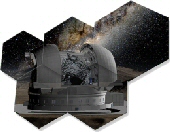Italiano:
In queste notti di fine Dicembre 2022, il pianeta Marte si trova molto alto in cielo, alle nostre latitudini boreali europee, soprattutto in orari “comodi” (intorno alle 22:00) e volgere lo sguardo al pianeta rosso per antonomasia, è veramente gratificante se lo si può soprattutto osservare e fotografare con l’ausilio di un telescopio di medie dimensioni.
In questa mia ripresa, effettuata il giorno di Natale di questo uscente anno 2022, si può ammirare passare in primo piano al meridiano centrale di Marte la zona denominata “Syrtis Major”, di colore più scuro, situato al confine tra le pianure settentrionali e gli altopiani meridionali di Marte appena ad ovest del bacino d’impatto Isidis nel quadrilatero di Syrtis Major. Sulla base dei dati della sonda Mars Global Surveyor, alla fine degli anni ’90, si scoprì che l’intero complesso era un antico vulcano a scudo, a basso rilievo, mentre in passato si credeva che fosse una pianura, appunto per questo chiamata Syrtis Major Planitia. Il colore scuro di questa zona, deriva dalla roccia vulcanica basaltica di questa regione e dalla relativa mancanza di polvere.
A sud della “Syrtis Major”, in posizione centrale più in basso in questa mia foto, si nota una zona di forma ellittica, più chiara rispetto al resto che la circonda: si tratta dell’enorme bacino “Hellas Planitia”, il secondo maggiore cratere da impatto di Marte, grande circa 2300 Km nel suo lato maggiore – da Est a Ovest – e profondo circa 7,152 km ( ! ), più profondo del Bacino Polare lunare di oltre 3 km. Il Bacino di Hellas è particolarmente visibile dalla Terra come una regione di colore uniforme a causa dell’elevata “albedo” (frazione di luce o, in questo caso, di radiazione solare incidente riflessa in tutte le direzioni) prodotta dal sollevamento costante di polveri causato dai venti della regione. È stata una delle prime formazioni individuate nel 1877 sulla superficie del pianeta rosso dall’astronomo Giovanni Schiaparelli che gli diede il caratteristico nome di “terra della Grecia” (Hellas).
Inserisco, infine, anche le riprese monocromatiche di ogni filtro R, G, B che ha creato la tricromia finale, frutto della somma di circa 1150 frames per ogni canale (filtro) scaturiti selezionando solo il 10% del totale dei circa 11500 frames per ogni ripresa di ogni singolo filtro alla velocità di circa 190 FPS (frame per secondo) unito ad un veloce tempo di ripresa (circa 1/4000 sec.), che hanno permesso di rendere meno pesante la cattiva condizione del seeing (valutato in diretta video a circa 6/10 della scala Pickering alla lunghezza d’0nda del canale rosso a 580nm).
Grazie per la Vs. cortese attenzione e …. ad maiora semper!
Dettagli Tecnici:
Telescopio Astrofaktorja DK20″ @ ~ F/28 – Televue 2″ PowerMate Barlow 2x – Baader RGB filters – Player One Saturn M camera – Seeing 6,5/10 in R band – sito: Palermo @ my personal Observatory.
********************************************************************************************************************
English:
In these late December 2022 nights, the planet Mars is very high in the sky at our European boreal latitudes, especially at “convenient” times (around 10.00 pm) and looking at the red planet is truly gratifying if you can above all observe and photograph it with a medium-sized telescope.
In this shot of mine, taken on Christmas day of this outgoing year 2022, you can admire the area called “Syrtis Major”, darker in color, located on the border between the northern lowlands and southern highlands of Mars just west of the Isidis impact basin in the Syrtis Major quadrangle.
Based on data from the Mars Global Surveyor probe, at the end of the 1990s, it was discovered that the entire complex was an ancient low-relief shield volcano, while in the past it was believed to be a plain, precisely for this reason called Syrtis Major Planitia. The dark color of this area derives from the basaltic volcanic rock of this region and from the relative lack of dust.
South of the “Syrtis Major”, in a central position further down in this photo of mine, there is an elliptical area, more clearer than the rest that surrounds it: it is the enormous “Hellas Planitia” basin, the second largest impact crater on Mars, about 2300 km large on its longest side – from East to West – and about 7,152 km deep ( ! ) , deeper than the lunar Polar Basin by more than 3 km.
The Hellas Basin is particularly visible from the Earth as a region of uniform color due to the high “albedo” (fraction of light or, in this case, of incident solar radiation reflected in all directions) produced by the constant lifting of dust caused by by the winds of the region. It was one of the first formations identified in 1877 on the surface of the red planet by the astronomer Giovanni Schiaparelli, who gave it the characteristic name of “land of Greece” (Hellas).
Finally, I also insert the monochrome stacked images of each R, G, B filter that created the final trichromy, which is the result of the sum and stack of about 1150 frames for each channel resulting from selecting only 10% of the total of about 11500 frames for each shooting of each single filter, at the speed of about 190 FPS (frames per second) combined with a fast shooting time (about 1/4000 sec.), which made it possible to make the bad seeing condition less heavy (evaluated live video at approximately 6/10 of the Pickering scale at the wavelength of the red channel at 580nm).
Thank you for your kind attention and …. ad maiora semper !
Technical Details:
Astrofaktorja DK20″ telescope @ ~ F/28 – Televue 2″ PowerMate Barlow 2x – Baader RGB filters – Player One Saturn M camera – Seeing 6.5/10 in R band – site: Palermo @ my personal Observatory.



